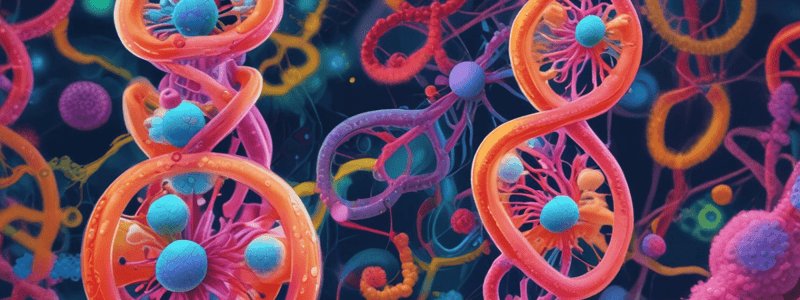Podcast
Questions and Answers
What is the main purpose of cell division in multicellular organisms?
What is the main purpose of cell division in multicellular organisms?
- For growth, renewal, and repair (correct)
- To create new organisms
- To increase genetic diversity
- To reduce the chromosome number by half
Which best describes a genome?
Which best describes a genome?
- A single chromosome within a cell
- A specific segment of DNA that contains a gene
- A type of protein associated with chromosomes
- The complete set of an organism's genetic material (correct)
What is chromatin?
What is chromatin?
- A cluster of ribosomes
- A single strand of RNA
- A complex of DNA and proteins that condenses during cell division (correct)
- A type of cell membrane
During cell division, what happens to sister chromatids?
During cell division, what happens to sister chromatids?
Which phase of the cell cycle involves the copying of chromosomes?
Which phase of the cell cycle involves the copying of chromosomes?
What crucial role does the mitotic spindle play?
What crucial role does the mitotic spindle play?
What is the process that describes the division of a bacterial cell into two daughter cells?
What is the process that describes the division of a bacterial cell into two daughter cells?
During cell division, what prevents the separation of sister chromatids until all chromosomes are properly attached to the spindle?
During cell division, what prevents the separation of sister chromatids until all chromosomes are properly attached to the spindle?
What is the name of the characteristic of cancer cells where they can divide indefinitely without being inhibited by normal regulatory processes?
What is the name of the characteristic of cancer cells where they can divide indefinitely without being inhibited by normal regulatory processes?
What occurs during metaphase of mitosis?
What occurs during metaphase of mitosis?
How do cancer cells differ from normal cells in terms of cell cycle control?
How do cancer cells differ from normal cells in terms of cell cycle control?
What is the role of cyclins and cyclin-dependent kinases in the cell cycle?
What is the role of cyclins and cyclin-dependent kinases in the cell cycle?
What describes the process of cytokinesis in animal cells?
What describes the process of cytokinesis in animal cells?
What signals regulate the cell cycle at the G1 checkpoint?
What signals regulate the cell cycle at the G1 checkpoint?
What is the function of the mitotic spindle during mitosis?
What is the function of the mitotic spindle during mitosis?
What is a characteristic of a benign tumor?
What is a characteristic of a benign tumor?
Flashcards are hidden until you start studying
Study Notes
Cell Division
- The primary function of cell division in multicellular organisms is for growth, renewal, and repair.
Genome and Chromatin
- A genome refers to the complete set of an organism's genetic material.
- Chromatin is a complex of DNA and proteins that condenses during cell division.
Cell Cycle
- During cell division, sister chromatids replicate and remain attached.
- The S phase of the cell cycle is characterized by the copying of chromosomes.
- The mitotic spindle plays a crucial role in chromosome movement during mitosis.
Cytokinesis
- Cytokinesis is the division of the cell's cytoplasm.
- In animal cells, cytokinesis occurs through the formation of a cleavage furrow that pinches the cell in two.
Cell Division in Bacterial Cells
- Binary fission is the process by which bacterial cells divide into two daughter cells.
Cancer Cells
- Cancer cells can divide indefinitely without being inhibited by normal regulatory processes.
- Cancer cells differ from normal cells in that they lack normal cell cycle control.
Cell Cycle Checkpoints
- Checkpoints in the cell cycle ensure that the cell is ready to proceed to the next phase, including the G1, S, and G2 checkpoints.
- Cohesins prevent the separation of sister chromatids until all chromosomes are properly attached to the spindle.
Cyclins and Cyclin-Dependent Kinases
- Cyclins and cyclin-dependent kinases regulate the cell cycle through fluctuating concentrations.
Mitosis
- During metaphase of mitosis, chromosomes line up at the metaphase plate.
- The role of the mitotic spindle during mitosis is to separate the sister chromatids.
Cell Cycle Control
- The cell cycle control system ensures the accurate distribution of chromosomes to daughter cells by monitoring the attachment of chromosomes to the spindle.
- External signals, such as growth factors, influence cell division by regulating the activity of cyclins and cyclin-dependent kinases.
Studying That Suits You
Use AI to generate personalized quizzes and flashcards to suit your learning preferences.




